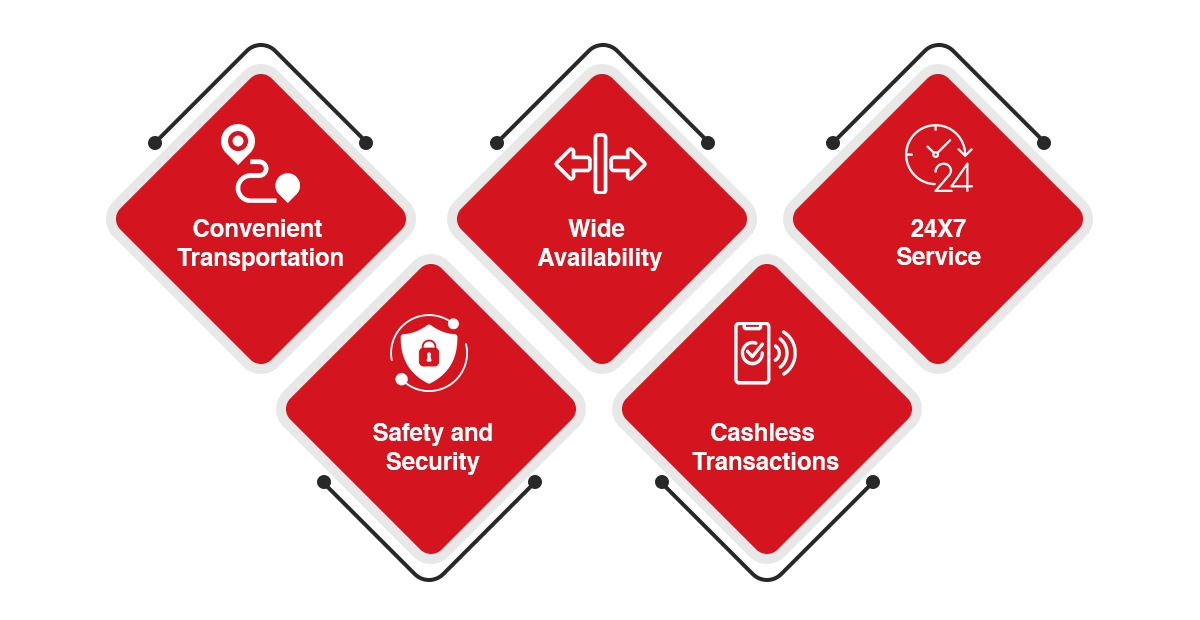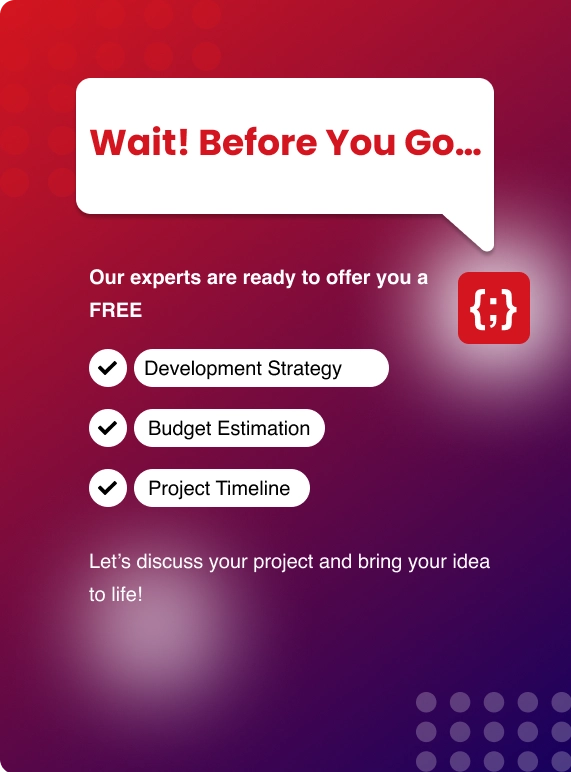To support the fact, the progress and success of OLA and UBER themselves are witnessed.
Taxi and cab booking apps have done wonders by creating personal cab booking system. Software companies are using technologies to develop applications like that. In this blog we will take you to a journey of development of taxi booking app like OLA/Uber.
Why Should Anyone Build This App?
But here’s the real shift: customers demand things like instant matching, transparent pricing, and safe travel. If your app can deliver these reliably, you stand out—and capture loyalty.
Benefits of Having an App Like OLA
Having an app like OLA, which is a popular ride-hailing service, comes with numerous benefits for both users and the business itself. Here are some of the key advantages:

1. Convenient Transportation
The app provides users with a seamless and convenient way to book rides. With just a few taps on their smartphones, users can request a ride, track their driver's location, and get real-time updates, making it much easier to travel from one place to another.
2. Wide Availability
OLA operates in multiple cities and regions, offering widespread availability of transportation services. This means users can access the service in various locations, even in places where traditional taxis may be hard to find.
3. 24/7 Service
The app operates 24/7, allowing users to book rides at any time of the day or night. This is especially beneficial for people who need transportation during odd hours or emergencies.
4. Safety and Security
OLA takes safety seriously and provides features such as driver verification, real-time tracking, and an SOS button in the app to ensure the safety of both passengers and drivers.
5. Cashless Transactions
The app offers cashless payment options, which eliminates the need for passengers to carry cash and helps ensure secure and hassle-free transactions. So, when an app so beneficial it is essential to have one.
Step by Step Guide to Develop an App Like OLA
Developing an app like OLA involves several technical steps. Below is a step-by-step guide to help you get started:
Step 1: Market Research and Planning
• Conduct thorough market research to understand user needs, competition, and trends in the ride-hailing industry.
• Define the scope and features of your app, such as ride booking, real-time tracking, payment options, etc.
• Create a detailed project plan, including timelines, resources, and milestones.
Step 2: Choose the Tech Stack
• Select the appropriate technology stack for your app, including the programming languages, frameworks, and databases.
• For a mobile app, you may use languages like Swift for iOS or Kotlin/Java for Android.
Step 3: Backend Development
• Build the server-side infrastructure to handle user requests, ride requests, and driver management.
• Implement a robust database to store user data, ride history, and other essential information.
Step 4: APIs and Integrations
• Develop APIs to allow communication between the mobile app and the server.
• Integrate third-party services for map and location services (e.g., Google Maps API).
Step 5: Mobile App Development
• Create the user interface (UI) and user experience (UX) design for both the passenger and driver apps.
• Implement features like registration, ride booking, real-time tracking, push notifications, and payment gateway integration.
• Ensure the app is intuitive, responsive, and user-friendly.

Step 6: Real-time Tracking and Geo-location
• Implement real-time tracking of drivers and passengers using GPS and map services.
• Integrate navigation features to guide drivers to the pickup and drop-off locations.
Step 7: Payment Gateway Integration
• Integrate secure payment gateways to enable cashless transactions within the app.
• Ensure the payment process is seamless and supports multiple payment options.
Step 8: Testing
• Conduct rigorous testing of the app to identify and fix any bugs or issues.
• Perform user testing to gather feedback and make necessary improvements.
Step 9: Security and Privacy
• Implement security measures to protect user data and ensure secure transactions.
• Comply with data privacy regulations to safeguard user information.
Step 10: Deployment and Launch
• Once the app is thoroughly tested and refined, deploy it to app stores (e.g., Apple App Store, Google Play Store).
• Plan a marketing strategy to promote the app's launch and attract users.
Step 11: Monitor and Maintain
• Continuously monitor the app's performance and user feedback to identify areas for improvement.
• Regularly update the app to fix bugs, add new features, and stay competitive.
Step 12: Scale and Expand
• As the user base grows, ensure your infrastructure can handle increased demand.
• Consider expanding to new regions or offering additional services to meet evolving market needs.
Developing an app like OLA is a complex process that requires collaboration between backend developers, mobile app developers, UI/UX designers, and quality assurance testers. It's essential to plan meticulously, prioritize security, and focus on delivering a smooth user experience to create a successful ride-hailing app.
Technology That You Need to Master to Develop This App
Developing an OLA-type app requires a robust technology stack that ensures seamless communication between users, drivers, and the backend server. Here are the key technologies typically used in the development of a ride-hailing app like OLA:
1. Mobile App Development
• For iOS: Swift (programming language) with Xcode (Integrated Development Environment).
• For Android: Kotlin or Java (programming languages) with Android Studio (Integrated Development Environment).
2. Backend Development
• Programming Languages: Node.js, Ruby on Rails, Python, or Java for building the backend server.
• Frameworks: Express.js for Node.js, Ruby on Rails for Ruby, Django for Python, Spring for Java.
3. Real-time Tracking and Geo-location
• Google Maps API or Mapbox API: To integrate real-time location tracking, geocoding, and route optimization for drivers and passengers.
4. Payment Gateway Integration
• For online payment processing: Stripe, Braintree, or PayPal API to handle secure and seamless transactions within the app.
5. Database Management
• Relational Database: PostgreSQL, MySQL, or SQL Server to store user data, ride history, and driver details.
• NoSQL Database: MongoDB or Firebase Firestore for handling real-time data and scalability.
6. Cloud Services and Hosting
• Cloud platforms like Amazon Web Services (AWS) or Microsoft Azure to host the backend server and manage scalability.
7. Push Notifications
• Firebase Cloud Messaging (FCM) or Apple Push Notification Service (APNS) to send real-time updates and notifications to users.
8. Authentication and Security
• JSON Web Tokens (JWT) or OAuth for secure user authentication and authorization.
• Secure Socket Layer (SSL) to encrypt data during communication.
9. App Performance Monitoring
• Crashlytics or Firebase Performance Monitoring to monitor app performance and identify issues.
10. Analytics and Tracking
• Google Analytics or Mixpanel for tracking user behavior, app usage, and other metrics.
11. SMS and Email Integration
• Third-party services like Twilio or Nexmo for SMS verification and communication with users.
12. DevOps and Version Control
• Tools like Git for version control and continuous integration/continuous deployment (CI/CD) pipelines for smooth development and deployment.
Integrating these technologies will help you build a feature-rich and reliable ride-hailing app similar to OLA. However, keep in mind that the choice of specific technologies may vary based on your team's expertise, project requirements, and scalability needs. Proper planning, continuous testing, and adherence to best practices will lead to a successful app that offers a seamless experience to users and drivers alike.
How Much does it Costs?
Pricing of any application that you want to get developed is based on the features that you are looking to have in it. As of my last update in September 2021, the cost of developing an app like Ola can vary significantly depending on various factors such as complexity, platform (iOS, Android, or both), location of development, and the development team's hourly rates. Additionally, ongoing maintenance, updates, and server costs should also be taken into consideration.
Creating an application that will help you strengthen your ride providing business may vary. A rough estimate of application like OLA and Uber can go from $40 to 50. Hence that comprises that the cost of the app can vary from $50,000 to $70,000 onwards.
The number of features and complexity the price will fluctuate. For a more accurate estimate, it is best to consult with a software development company or a team of experienced developers like Zeneys. They will be able to analyze your specific requirements and provide you with a detailed cost breakdown for developing an app like Ola tailored to your needs.
Zenesys Ace the Art of Developing Apps
So, being in the industry for now more than a decade, we have mastered the art of developing an intuitive cab booking app. We have served our clients with top-notch mobile apps that have helped to meet their target of generating their desired ROI.
Zenesys goes beyond coding. We assist from day one with market and competitor analysis, helping define what users really want. They guide you through each step—wireframing, design feedback, building for scale, and meeting regulatory demands.
With skilled and talented developers, we master all the top technologies that will help you to develop your ideal application. We have our process to reach the target. Trends is our strength, as we believe that trends will help us to keep a step ahead.
Zenesys Technosys can help you develop a high-quality OLA type app by leveraging their expertise in mobile app development, real-time tracking, secure payment gateway integration, and user-friendly interfaces. With a skilled team of developers and a focus on delivering seamless user experiences, they ensure your app meets industry standards and user expectations.
Conclusion
In conclusion, creating an OLA-type app requires meticulous planning, cutting-edge technology, and an unwavering commitment to user satisfaction. By conducting thorough market research, conceptualizing a user-friendly interface, and employing the right technology stack, you can lay a strong foundation.
The development process should be agile, ensuring a robust and scalable app with essential features like real-time tracking and multiple payment options. Rigorous testing guarantees a reliable and secure platform.
Launching the app-on-app stores and promoting it strategically is vital for attracting users and gathering valuable feedback. Continuous improvement, based on user insights and market trends, will enable the app to stay ahead in the competitive ride-hailing industry. With innovation and dedication, your OLA-type app can revolutionize the way people commute, establishing a strong presence in the market.
Frequently Asked Questions
Q1. Why is market research crucial before building an OLA-type app?
Market research helps you understand your target audience, their preferences, and the competitive landscape. This information is vital for identifying opportunities, differentiating your app, and meeting user demands effectively.
Q2. What are the essential steps for conceptualizing and designing the app's user interface?
To create an engaging user interface, focus on user experience, intuitive navigation, and seamless interactions. Conduct user surveys, design wireframes, and prototype iterations to gather feedback and refine the UI.
Q3. Which technology stack should I use to develop a robust OLA-like platform?
The technology stack typically includes a backend framework (e.g., Node.js or Ruby on Rails), a database (such as MySQL or MongoDB), and native or cross-platform development for mobile apps (e.g., Swift for iOS, Java/Kotlin for Android, or React Native).
Q4. How can I ensure the app's security and reliability through rigorous testing?
Implement thorough testing processes, including functional testing, load testing, and security audits. Use automated testing tools to identify and fix bugs and vulnerabilities before the app's launch.
Q5. What effective strategies should I follow to launch and promote the app successfully?
Plan a strategic marketing campaign targeting your ideal users. Utilize social media, online advertising, and partnerships to create buzz. Offer promotional incentives and referral programs to attract a substantial initial user base. Continuously monitor user feedback and make improvements to enhance the app's performance and user satisfaction.
Q6. What Features Do Riders Expect Most?
People want to book a ride quickly, track every step, and know exactly what they’re paying. Here’s what users look for:
- Fast sign-up (via phone, email, or social). No wasted steps—just get moving.
- Real-time maps, GPS tracking, and routing. Riders want to see where drivers are, from pickup to drop-off.
- Fare calculation before booking. Nobody likes hidden fees or vague pricing.
- Driver profiles and ratings, plus trip history. Trust grows when everything’s transparent.
- In-app messaging and calls, so riders and drivers can sort out pickup details safely.
- Ride cancellation and flexible scheduling. Life changes fast—flexibility wins loyalty.
- Multiple payment methods, including digital wallets. If it’s cash only, most users will bounce.
- Emergency help button and phone number masking for privacy. People want to feel protected at every step.
- Instant notifications about trip status. If updates lag, anxiety spikes and so does support volume.
Q7. How Long Will It Take to Build?
This one depends on your budget, goals, and features. On average:
- MVP (basic, working app): Expect 3–6 months. This gets you rides, payments, and live maps.
- Full-featured launch: Think 8–15 months (sometimes even longer for large custom projects).
- White-label or template-based: You could be ready in 30–45 days—but flexibility and uniqueness are limited.
- Ready to launch fast? Stick to essentials first, then add features once real users start booking and giving feedback.
Q8. What’s the Best Tech Stack Right Now?
Pick tools built for speed and scale—but don’t overcomplicate. Leading app builders recommend this mix:
- Mobile: Swift for iOS, Kotlin or Java for Android.
- Cross-platform: Flutter or React Native—great for quicker launches and budget saves.
- Backend: Node.js or Python for real-time matching and chat.
- Data: PostgreSQL or MongoDB for storing rides, user info, and more.
- Maps: Google Maps API for GPS, routing, and live ETA.
- Hosting/cloud: AWS, Azure, or Firebase. Go cloud for lower upfront costs and easier scaling.
- Push Notifications: Firebase Cloud Messaging (FCM) or Apple Push for instant updates.
Ask your dev team for a simple, modular setup that’s easy to update and cheap to maintain.
Q9. How Do Safety Features Build Trust?
Safety isn’t a nice-to-have—customers demand it. Here are features that keep users and drivers loyal:
- SOS button for instant emergency help—one tap and responders get sent location details.
- Real-time driver verification via selfie or ID for every shift.
- Ride tracking from start to finish. Family can follow, riders feel watched over.
- Phone number masking keeps contact info private.
- 24/7 customer support for incidents or confusion. Quick answers mean less stress, fewer complaints.
- Ratings and feedback after every ride. Transparency pushes everyone to do better.
Data shows apps that add multiple safety features see a 20–30% rise in retention—especially among women and late-night riders.
Q10. What’s Trending in Ride-Sharing Apps?
Tech moves fast. Don’t chase every shiny object—focus on trends that boost your app’s value or give you a real edge.
- Autonomous vehicles: Testing is underway. Future versions might manage fleets without drivers.
- Electric and hybrid car focus: Environmental impact matters. Apps can show carbon savings or offer cheaper eco rides.
- Super-app features: Bundling ride-hailing, delivery, and payments—think Grab or Gojek—is booming.
- Advanced AI: Predictive routing, smarter fare estimates, and tailored offers keep people hooked.
- IoT and connected vehicles: Monitor cars in real-time for safety and maintenance. This data can cut costs and improve reliability.
- Blockchain: Faster, lower-fee payments and decentralized ride matching are being tested in real-world pilots.
- Health safety: Post-pandemic, contactless payments, and health checks for drivers remain highly rated.
Key Points to Remember
- People choose the fastest, safest, most transparent app that solves real travel headaches.
- Build only what you need first—launch, learn, and grow with feedback.
- The right tech stack makes updates and scaling easier. Don’t overcomplicate.
- Safety features aren’t optional—they build lasting loyalty and protect your brand.
- Trends that matter are shaping the ride-hailing world today. Build for what users want now, but stay ready to pivot when new tech comes along.


.webp?lang=en-US&ext=.webp)

.webp?lang=en-US&ext=.webp)

